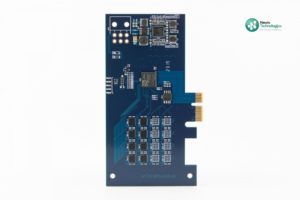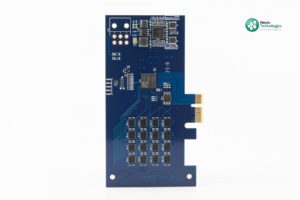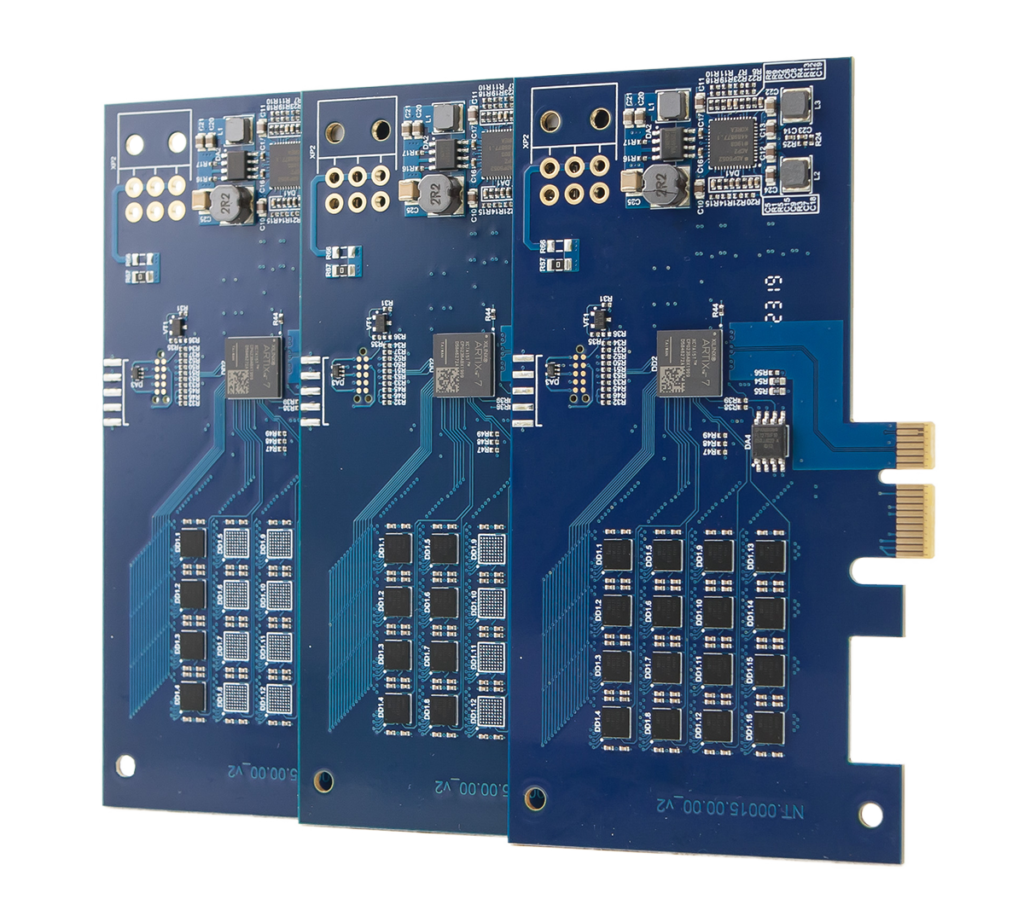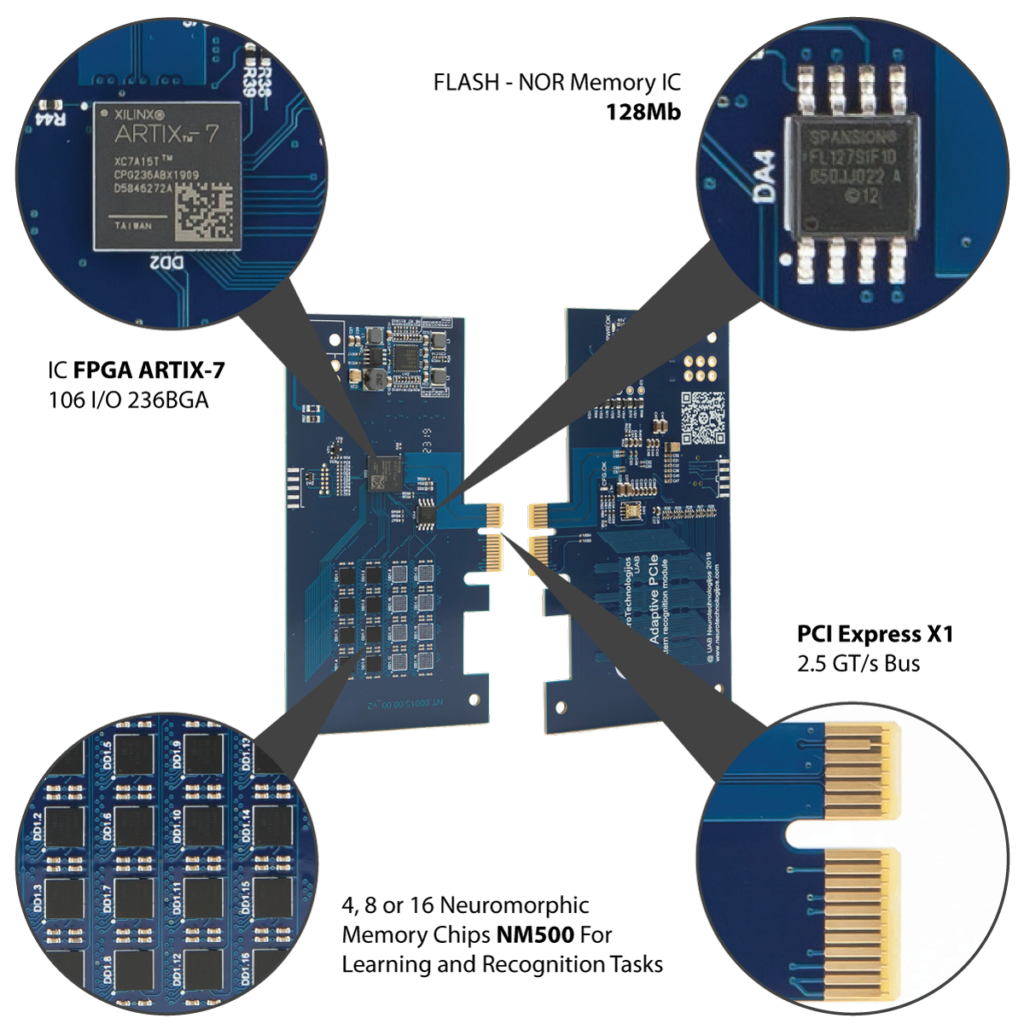NT Adaptive ™ PCIe
Technical Specifications
| Recognizes: | Signals, Images, Video |
| Montage: | 2U enclosure |
| Control: | FPGA |
| Neurochip: | NM500 |
| Number of neurochips: | 4 |
| Number of neurons: | 2304 |
| Vectors per second: | < 96 μsec |
| Max vector length: | 256 Byte |
| FLASH memory: | Internal PC memory |
| Ports: | PCIEx Bus |
| Interfaces: | PCI Express X1 2.5 GT/s |
| RTC: | No |
| Power: | 12V DC |
| Power Consumption: | <4 Watt |
| Dimensions (HxLxW): | 8x120x68 mm |
Technical Specifications
| Recognizes: | Signals, Images, Video |
| Montage: | 2U enclosure |
| Control: | FPGA |
| Neurochip: | NM500 |
| Number of neurochips: | 8 |
| Number of neurons: | 4608 |
| Vectors per second: | < 96 μsec |
| Max vector length: | 256 Byte |
| FLASH memory: | Internal PC memory |
| Ports: | PCIEx Bus |
| Interfaces: | PCI Express X1 2.5 GT/s |
| RTC: | No |
| Power: | 12V DC |
| Power Consumption: | <4 Watt |
| Dimensions (HxLxW): | 8x120x68 mm |
Technical Specifications
| Recognizes: | Signals, Images, Video |
| Montage: | 2U enclosure |
| Control: | FPGA |
| Neurochip: | NM500 |
| Number of neurochips: | 16 |
| Number of neurons: | 9216 |
| Vectors per second: | < 96 μsec |
| Max vector length: | 256 Byte |
| FLASH memory: | Internal PC memory |
| Ports: | PCIEx Bus |
| Interfaces: | PCI Express X1 2.5 GT/s |
| RTC: | No |
| Power: | 12V DC |
| Power Consumption: | <4 Watt |
| Dimensions (HxLxW): | 8x120x68 mm |
SERIES OF NEUROMORPHIC CONTROL BOARDS WITH PCIE INTERFACE
Neuromorphic memory NT Adaptive PCIe series control boards have no microcontroller and can be mounted in any PC or other device with a PCIe connector. NT Adaptive PCIe boards come in three versions – with 4, 8 or 16 neural chips.
Video Examples
The opportunity of neuromorphic to identify the positions of circuit breakers, LEDs indicating real equipment is presented.
The program is developed on Python and combines various options for demonstrating the possibility of neuromorphic chips. Recognition of positions of automatic power supply units, light indication of control lamps, indications of dial gauges, values of seven-segment indicators, positions of biscuit switches.
The demo program written in Python is shown. This demo program uses a combination of the OpenCV open library and the CM1K chip (NM500) when working with the PCIe expansion board. OpenCV was used to search for faces in photographs, the training and recognition of the faces themselves was performed using neuromorphic chips.
Demonstration of the program developed on Python. Demonstration of the sequence of image selection, ROI selection, selection and tuning of parameters of a neuromorphic chip, such as MAXIF, categories, training and verification of learning outcomes. This program uses neuromorphic chips on a PCIe board.
Neuromorphic Controller
Overview
The NT Adaptive PCIe is a fully parallel silicon neural network – it is a chain of identical elements (neurons) addressed in parallel and which have their own “genetic” material to learn and recall patterns without running a single line of code and without reporting to any supervising unit. In addition, the neurons fully collaborate with each other through a bi-directional and parallel neuron bus which is the key to accuracy, adaptivity and speed performance. Indeed, each neuron incorporates information from all the other neurons into its own learning logic and into its response logic.
Access to the network is through the PCIe interface.
Controller description
Neural network key features
- Group of 2304 neurons (up to 256 components) identical neurons recognizing the same input pattern in parallel;
- The size of components – 8 bit;
- All neurons have the same behavior and execute the instructions in parallel independent from the cluster or even chip they belong to;
- High-speed learning and recognition for one neuron(<80 μsec);
- The neurons can be associated to different contexts (up to 128) and their use can be enabled or disabled by selecting a context value;
- No controller or supervisor;
- Selection of one out of two classifiers: K-Nearest Neighbor (KNN) or Radial Basis Function (RBF);
- Selection of one out of two metrics: L1(Manhattan distance) or Lsup(Chebyshev distance);
- Recognition time is independent of the number of neurons in use;
- Automatic model generator built into the neurons
Operations
- The interface to neural network comes down to 4 main operations:
- Learn a vector;
- Recognize a vector;
- Save the knowledge built by the neurons;
- Load a knowledge into the neurons.
These operations are executed through API functions.
Data structure
The content of each neuron is saved in 263 bytes as follows:
- 256 bytes of vector;
- 1 byte of context;
- 2 bytes of minimum influence field;
- 2 bytes of active influence field;
- 2 bytes of category.
Electrical specifications
Vcc power supply 12 VDC
Total power up to 4 W
Interface specification
PCI Express X1 2.5 GT/s (PCI Express Base Specification, rev.2.1)
Mechanical specification
For installation in a 2U enclosure.
Dimension 120×68 mm.
Climatic specification
Operating Temperature -40…+60 ℃
Storage Temperature -50… +80 ℃
NT Adaptive AI controllers identify various signals and makes programmed action.
NT Adaptive PCIe neural boards can recognize static and video images, sounds, various electrical signals, text, data.
Signal recognition process in neuromorphic chips takes place at the hardware level and makes huge acceleration for central processor. Controllers recognize signals in microseconds with only milliwats of power.
Possibilities:
- Identification;
- Classification;
- Novelty detection;
- Anomaly detection;
- Image contextual segmentation;
- Tracking with reinforced learning as the target changes;
- Stereoscopic distance evaluation;
- Edge detection;
- Noise removal;
- Image compression;
- and others.
Areas of implementation:
- Industry;
- Agriculture;
- Medicine;
- Military;
- Security;
- Statistics;
- Education;
and others.
NT Adaptive PCIe board dimensions: 120x68x20 mm
NT Adaptive PCIe neural board panels can contain 2304, 4608 or even 9216 neurons.
Neural Network access takes place via the PCIe interface.







